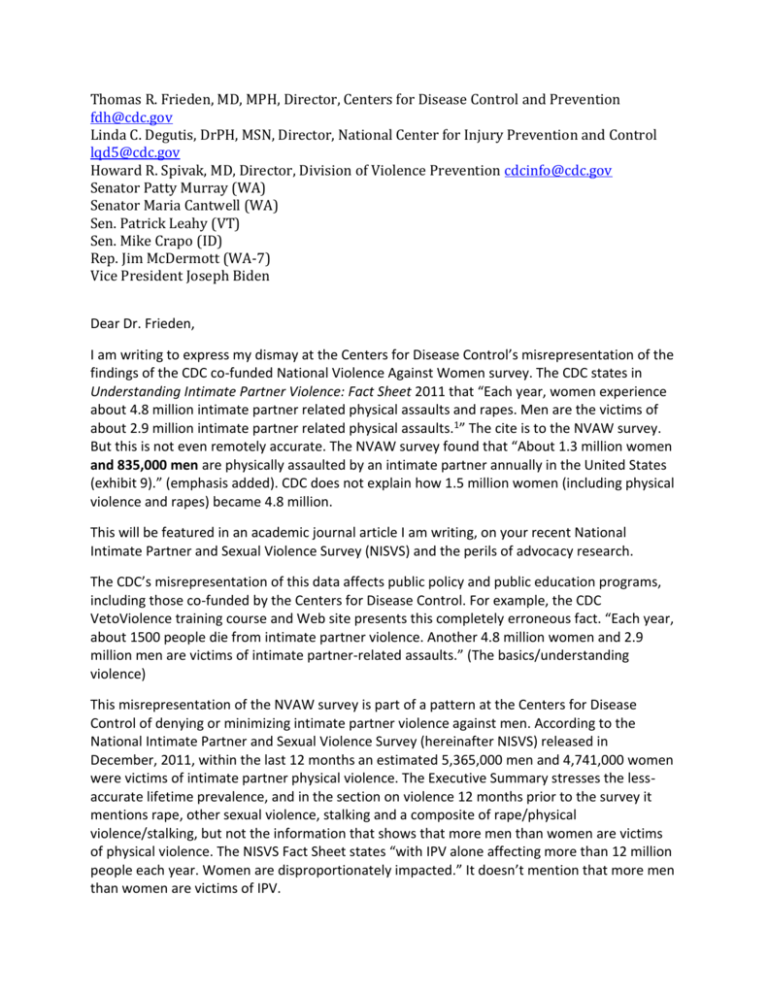
Thomas R. Frieden, MD, MPH, Director, Centers for Disease Control and Prevention
fdh@cdc.gov
Linda C. Degutis, DrPH, MSN, Director, National Center for Injury Prevention and Control
lqd5@cdc.gov
Howard R. Spivak, MD, Director, Division of Violence Prevention cdcinfo@cdc.gov
Senator Patty Murray (WA)
Senator Maria Cantwell (WA)
Sen. Patrick Leahy (VT)
Sen. Mike Crapo (ID)
Rep. Jim McDermott (WA-7)
Vice President Joseph Biden
Dear Dr. Frieden,
I am writing to express my dismay at the Centers for Disease Control’s misrepresentation of the
findings of the CDC co-funded National Violence Against Women survey. The CDC states in
Understanding Intimate Partner Violence: Fact Sheet 2011 that “Each year, women experience
about 4.8 million intimate partner related physical assaults and rapes. Men are the victims of
about 2.9 million intimate partner related physical assaults.1” The cite is to the NVAW survey.
But this is not even remotely accurate. The NVAW survey found that “About 1.3 million women
and 835,000 men are physically assaulted by an intimate partner annually in the United States
(exhibit 9).” (emphasis added). CDC does not explain how 1.5 million women (including physical
violence and rapes) became 4.8 million.
This will be featured in an academic journal article I am writing, on your recent National
Intimate Partner and Sexual Violence Survey (NISVS) and the perils of advocacy research.
The CDC’s misrepresentation of this data affects public policy and public education programs,
including those co-funded by the Centers for Disease Control. For example, the CDC
VetoViolence training course and Web site presents this completely erroneous fact. “Each year,
about 1500 people die from intimate partner violence. Another 4.8 million women and 2.9
million men are victims of intimate partner-related assaults.” (The basics/understanding
violence)
This misrepresentation of the NVAW survey is part of a pattern at the Centers for Disease
Control of denying or minimizing intimate partner violence against men. According to the
National Intimate Partner and Sexual Violence Survey (hereinafter NISVS) released in
December, 2011, within the last 12 months an estimated 5,365,000 men and 4,741,000 women
were victims of intimate partner physical violence. The Executive Summary stresses the lessaccurate lifetime prevalence, and in the section on violence 12 months prior to the survey it
mentions rape, other sexual violence, stalking and a composite of rape/physical
violence/stalking, but not the information that shows that more men than women are victims
of physical violence. The NISVS Fact Sheet states “with IPV alone affecting more than 12 million
people each year. Women are disproportionately impacted.” It doesn’t mention that more men
than women are victims of IPV.
The public and policy-makers will not read the 112-page NISVS report. Instead, they will rely on
the CDC’s Executive Summary and Frequently Asked Questions . Here is what the FAQ says
about intimate partner violence:
Q: Does this report show how both males and females experience violence?
Yes, although women are frequently at greater risk of victimization and our findings are
reported separately for females and males. For example, the results indicate that nearly 1 in 5
women (18%) and 1 in 71 men (1%) in the United States have been raped at some time in their
lives and 1 in 2 women (45%) and 1 in 5 men (22%) have experienced sexual violence other
than rape, including being made to penetrate someone else and unwanted sexual contact. One
in 6 women (16%) and 1 in 19 men (5%) in the United States have experienced stalking
victimization during their lifetime in which they felt very fearful or believed that they or
someone close to them would be harmed or killed.
There is no mention that more men than women experienced physical violence in the past year.
In a similar vein, the Centers for Disease Control’s 2009 Youth Risk Behavior Survey (YRBS)
found that 10.3% of males and 9.3% of females had been victimized. The 2003 YRBS found that
8.9% of students (8.9% of males and 8.8% of females) reported PDV victimization during the 12
months preceding the survey. Yet your teen dating violence focus is on girls as victims.
What is disturbing is that the public and policy-makers look to the CDC for guidance, for
example in the debate on renewal of the Violence Against Women Act. In 2005, the Federal
government spent $835 million on domestic violence. $3 million went to programs to engaging
men in preventing domestic violence, but none of this went to public education efforts or
programs to help male victims. In fact, the U.S. Department of Justice specifically prohibited use
of this domestic violence funding to research domestic violence against men. Policy-makers also
use this information in making decisions on state-level funding of domestic violence programs,
training for police, prosecutors and courts, and other public policy endeavors.
The Centers for Disease Control owes it to the public and the taxpayers to present full, fair and
accurate information, not the misrepresentations and distortions like that found in your
Understanding Intimate Partner Violence: Fact Sheet and VetoViolence training course.
Sincerely,
Bert H. Hoff, J.D.
Seattle and Online Faculty, University of Phoenix
berthoff@email.phoenix.edu (primary)
berthoff@comcast.net (secondary)
(206) 522-9701 (10 am - 9 pm Pacific)









